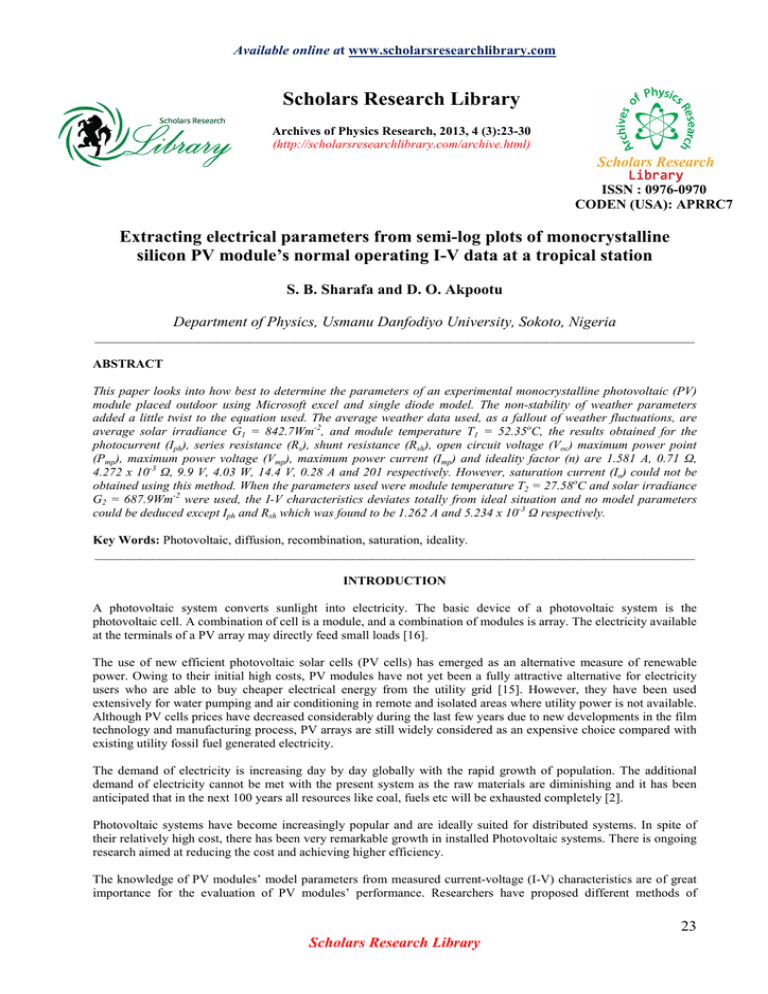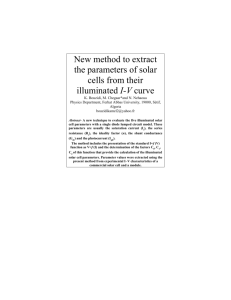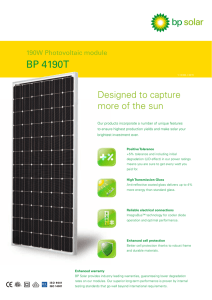Extracting electrical parameters from semi
advertisement

Available online at www.scholarsresearchlibrary.com Scholars Research Library Archives of Physics Research, 2013, 4 (3):23-30 (http://scholarsresearchlibrary.com/archive.html) ISSN : 0976-0970 CODEN (USA): APRRC7 Extracting electrical parameters from semi-log plots of monocrystalline silicon PV module’s normal operating I-V data at a tropical station S. B. Sharafa and D. O. Akpootu Department of Physics, Usmanu Danfodiyo University, Sokoto, Nigeria _____________________________________________________________________________________________ ABSTRACT This paper looks into how best to determine the parameters of an experimental monocrystalline photovoltaic (PV) module placed outdoor using Microsoft excel and single diode model. The non-stability of weather parameters added a little twist to the equation used. The average weather data used, as a fallout of weather fluctuations, are average solar irradiance G1 = 842.7Wm-2, and module temperature T1 = 52.35oC, the results obtained for the photocurrent (Iph), series resistance (Rs), shunt resistance (Rsh), open circuit voltage (Voc) maximum power point (Pmp), maximum power voltage (Vmp), maximum power current (Imp) and ideality factor (n) are 1.581 A, 0.71 Ω, 4.272 x 10-3 Ω, 9.9 V, 4.03 W, 14.4 V, 0.28 A and 201 respectively. However, saturation current (Io) could not be obtained using this method. When the parameters used were module temperature T2 = 27.58oC and solar irradiance G2 = 687.9Wm-2 were used, the I-V characteristics deviates totally from ideal situation and no model parameters could be deduced except Iph and Rsh which was found to be 1.262 A and 5.234 x 10-3 Ω respectively. Key Words: Photovoltaic, diffusion, recombination, saturation, ideality. _____________________________________________________________________________________________ INTRODUCTION A photovoltaic system converts sunlight into electricity. The basic device of a photovoltaic system is the photovoltaic cell. A combination of cell is a module, and a combination of modules is array. The electricity available at the terminals of a PV array may directly feed small loads [16]. The use of new efficient photovoltaic solar cells (PV cells) has emerged as an alternative measure of renewable power. Owing to their initial high costs, PV modules have not yet been a fully attractive alternative for electricity users who are able to buy cheaper electrical energy from the utility grid [15]. However, they have been used extensively for water pumping and air conditioning in remote and isolated areas where utility power is not available. Although PV cells prices have decreased considerably during the last few years due to new developments in the film technology and manufacturing process, PV arrays are still widely considered as an expensive choice compared with existing utility fossil fuel generated electricity. The demand of electricity is increasing day by day globally with the rapid growth of population. The additional demand of electricity cannot be met with the present system as the raw materials are diminishing and it has been anticipated that in the next 100 years all resources like coal, fuels etc will be exhausted completely [2]. Photovoltaic systems have become increasingly popular and are ideally suited for distributed systems. In spite of their relatively high cost, there has been very remarkable growth in installed Photovoltaic systems. There is ongoing research aimed at reducing the cost and achieving higher efficiency. The knowledge of PV modules’ model parameters from measured current-voltage (I-V) characteristics are of great importance for the evaluation of PV modules’ performance. Researchers have proposed different methods of 23 Scholars Research Library S. B. Sharafa et al Arch. Phy. Res., 2013, 4 (3):23-30 ______________________________________________________________________________ extracting the parameters of a PV module, which includes saturation current (Is), series resistance (Rs), shunt resistance (Rsh), ideality factor (n) and photocurrent (Iph). There are simple electrical models that show a good accuracy, as well as more complex models that take into account other phenomena inside PV cell. There are also empirical models that are valid for certain PV cells. Analysis of the temperature characteristics is necessary, because it is an important parameter that governs semiconductor carrier transport [13] PV cells can be modeled as a current source in parallel with a diode. When there is no light present to generate any current, the PV cell behaves like a diode. As the intensity of incident light increases, current is generated by the PV cell, as illustrated in Figure 1. The search for methods to estimate these parameters based on experimental data is justified by the difficulty in determining the values of some variables that describe the analytical equations, when focusing on an analysis of the chemistry and physics of materials. [4] Figure 1 – I-V Curve of PV cell and Associated Electrical Diagram In an ideal cell, the total current I is equal to the current Iph generated by the photoelectric effect minus the diode current Id and correction term Ip, according to the equation: = − = − − ( ) −1 − (1) + (2) Which can be re-written as − = −1 + + (3) Where Iph, Id, Is, n, Rs and Rsh being the photocurrent, the diode current, the diode saturation current, the diode quality factor, the series resistance and the shunt resistance, respectively. Deviations in the ideality factor from the value of one indicate that either there are unusual recombination mechanisms taking place or that the recombination is changing in magnitude. Thus the ideality factor is a powerful tool for examining the recombination in a device. The measurement of diode saturation current (Is) is only valid when the ideality factor is stable. An equation for evaluating the ideality factor of a diode is n=β ∂V ∂(lnJ) (4) where J is the current density. For large forward-bias voltage, n ≈ 1 when diffusion dominates, and for low forwardbias voltage, n ≈ 2 when recombination dominates [5, 6]. The local ideality factor of a PV cell in the dark can also be calculated using equations (5), (6) or (7) [7]: & (5) #= % ' $ & 24 Scholars Research Library S. B. Sharafa et al Arch. Phy. Res., 2013, 4 (3):23-30 ______________________________________________________________________________ For its calculation, the inverse slope at each point of the I - V curve must be calculated. In the case of illuminated characteristics, the current, I, must be substituted by ISC – I. ) #= − & * + $ &( ) − ) (6) $ = 0./ is the usual inverse thermal voltage, where q is the elementary charge 1.6 x 10-19 C, k is a constant of value 1.38 x 10-23J/K, T is the cell temperature in Kelvin, and V is the measured cell voltage [1]. Eq (6) can be modified by adding a series resistance compensation term (IRS) to the voltage, V, term. By taking the number of cells in series (NS) into account, the expression becomes valid also for PV modules: − &( + * + $ &( ) − ) ) #1 = (7) The ideality factor used in a single diode equivalent model of PV cells is confusing in that n = 1 is for predominantly diffusion processes while n = 2 is for predominantly recombination processes. If an author uses n = 1 or n = 2 for any case involving a single diode equivalent model, then such author could be said to be bias in his/her analysis. The parameter extraction is carried out mainly based on experimental measurements on a 17 W SONCUP monocrystalline PV module. The aim of this paper is to investigate the applicability of the proposed method for improving the extraction accuracy of PV module’s electrical parameters using the single diode equivalent model. The simplest model of a PV cell equivalent circuit consists of an ideal current source in parallel with an ideal diode. The current source represents the current generated by photons (often denoted as Iph), and its output is constant under constant temperature and constant incident radiation of light. The PV module is usually represented by the single exponential model or the double exponential model. The single diode equivalent model is shown in fig. 2. The current is expressed in terms of voltage, current and temperature as shown in equation (2) which is a nonlinear equation. Figure 2 Simplified Equivalent Circuit Model for a Photovoltaic Cell Furthermore, the parameters (Iph, Io, Rs, Rsh and n) vary with temperature, irradiance and depend on manufacturing tolerance. Numerical methods and curve fitting can be used to estimate them. Where Iph is given at short circuit, V = 0, by eq (9) [8, 10] 3 7 3456 = From [12], at R = 0 and V = 0, ,456 = ,456 ),456 , +9 ) :/ = − /456 ;< ) (8) (9) Where G is the incident solar irradiation on the PV module, µ?@A = 0.0017 A/oC is the temperature coefficient of the short circuit current and T is module temperature. The subscript ref denotes the value of the related parameter at the reference operating condition. The series resistance is given by [11] = B) − (10) 25 Scholars Research Library S. B. Sharafa et al Arch. Phy. Res., 2013, 4 (3):23-30 ______________________________________________________________________________ The shunt resistance is given by eq (11), [12] 3.6 = 3 − 0.086 (11) We divide the eq (3) by IFG to make it dimensionless and then take its natural logarithm; the high-voltage approximation then gives H# − ≈ H# + $ ( + # ) If the value of Rs is known and n is constant with bias, the plot of H# % voltages, with a slope equal to equal H# % JK (12) JK JK ' versus L will be linear at higher from which n can be deduced. The vertical axis intercept of the vertical axis will ' from which Is is easily derived [7]. The information on the data sheet of the module used is as shown below. They are taken at standard test condition (STC) i.e. at 1000 Wm-2 solar irradiance, 1.5 air-mass (AM) and a temperature of 25 oC. The five parameters in eq (8) depend on the incident solar irradiance, cell temperature, and on their reference values at STC [14]. MATERIALS AND METHODS The 17 W SONCUP monocrystalline solar module used in this study consist of 12 monolithically integrated series connected cells. The module was deployed outdoor during the months of May and June of the year 2010 in Bali Local Government Area of Taraba State, Nigeria with a load of 5Ω, and I-V data were obtained daily at solar noon for three (3) hours at fifteen (15) minutes interval using a five-in-one multimeter. Module ambient temperatures were also recorded. The data for daily insolation was obtained from energy research centre’s meteorological station. The data generated were used to first, obtain the value of Iph. I-V curves were obtained from where the Voc was estimated and then a plot of H# % JK JK ' against L are used to extract values for n Io at different average module temperature. The method is implemented in Microsoft Office Excel 2007. Table 1: Specification of 17 W SONCUP monocrystalline solar panel Peak power (Pmax) Rated voltage (Vmp) Rated current (Imp) Open circuit voltage (Voc) Short circuit current (Isc) Dimensions Number of cells in series 17 W 10 V 1.72 A 11.9 V 1.83 A 170 x 78 x 5 mm 12 The plots obtained using the generated data are shown in fig. 3 – fig. 7 26 Scholars Research Library S. B. Sharafa et al Arch. Phy. Res., 2013, 4 (3):23-30 ______________________________________________________________________________ 0.3 current (A) 0.25 0.2 0.15 0.1 0.05 0 0 2 4 6 8 10 12 14 16 voltage (V) figure 3 current-voltage relatioship for the module at average module temperature T = 52.35oC and solar irradiance G = 842.7Wm-2 0.14 0.12 current (A) 0.1 0.08 0.06 0.04 0.02 0 0 1 2 3 4 5 6 7 8 voltage (V) figure 4 current-voltage relatioship for the module at average module temperature T = 27.58oC and solar irradiance G = 687.9Wm-2 27 Scholars Research Library S. B. Sharafa et al Arch. Phy. Res., 2013, 4 (3):23-30 ______________________________________________________________________________ 0 1.08 1.09 1.1 1.11 1.12 1.13 1.14 1.15 1.16 ln(Iph -I)/Iph -0.05 -0.1 y = -0.177x R² = -0.07 -0.15 -0.2 -0.25 (V+IRs)/Ns figure 5 semi-log plot for the module parameters at T = 52.35oC and G = 842.7Wm-2 4.5 4 3.5 power (W) 3 2.5 2 1.5 1 0.5 0 13.9 14 14.1 14.2 14.3 14.4 14.5 14.6 14.7 14.8 14.9 Voltage (V) Figure 6 Power-Voltage characteristic curve for the module at T = 52.35oC and G = 842.7Wm-2 28 Scholars Research Library S. B. Sharafa et al Arch. Phy. Res., 2013, 4 (3):23-30 ______________________________________________________________________________ 1.4 1.2 Power (W) 1 0.8 0.6 0.4 0.2 0 0 1 2 3 4 5 6 7 8 9 Voltage (V) Figure 7 Power-Voltage characteristics of the module at T = 27.58oC and G = 687.9Wm-2 RESULTS AND DISCUSSION The Voc and Isc obtained from fig. 3 are 14.2 V and 0.23 A. Therefore the value for Rs calculated is 0.71 Ω. The plot in fig. 4 does not have all I-V curve characteristics that will enable us deduce Isc, Voc, Io, Rs, Rsh and n. Iph was calculated to be 1.262 A. The saturation current Io cannot be obtained as there is no intercept on the plot of fig. 5. Fig. 6 have some of the basic characteristics of an ideal P-V curve, therefore some parameters can be extracted from it. Fig. 7 does not have any of the basic characteristics of a P-V curve; therefore no meaningful deductions can be made from it. From the experiments carried out, the values of parameters obtained are shown in Table 2 below. Table 2: parameters extracted from the 17 W SONCUP monocrystalline solar panel Parameters Maximum power (Pmax) Maximum power voltage (Vmp) Maximum power current (Imp) Open circuit voltage (Voc) Short circuit current (Isc) Photocurrent (Iph) Series resistance (Rs) Shunt resistance (Rsh) Ideality factor (n) At temperature T = 52.35oC and G = 842.7Wm-2 4.03 W 14.4 V 0.28 A 14.2 V 0.23 A 1.581 A 7.1 x 10-1 Ω 4.272 x 10-3 Ω 201 At T = 27.58oC and G = 687.9Wm-2 1.262 A 5.234 x 10-3 Ω - CONCLUSION It is observed that data generated with solar irradiance less than 800 Wm-2 deviates from ideal situation when their IV characteristics are considered. It is also useful to note that since real data are being used for this work, the atmospheric parameters like temperature and solar irradiance fluctuates as much as the weather on site fluctuates 29 Scholars Research Library S. B. Sharafa et al Arch. Phy. Res., 2013, 4 (3):23-30 ______________________________________________________________________________ thereby giving us varying data within a short time interval i.e. semiconductor devices operation depends so much on temperature [13]. Another reason may be because the study took place at moderate voltages thereby interfering with the series resistance effect and making the local ideality factor be well above n = 1 [7]. One other reason is that the time interval between each reading is high thereby affecting the value of photocurrent for each set of reading. REFERENCES [1] M. Chegaar, Z. Ouennoughi, F. Guechi, and H. Langueur, Journal of Electron Devices, 2003, 2, 17 - 21 [2] S. N. Singh, Pooja Singh, Swati, Swati Kumari, and R. Jha, International Journal of Advanced Engineering Sciences and Technologies 2011, 4 (1), 015 – 021 [3] Adel El Shahat, Journal of Theoretical and Applied Information Technology, 2010, 16, (1), 9 – 20 [4] P. Rodrigues, J. R. Camacho, and F. B. Matos, International Conference on Renewable Energies and Power Quality (ICREPQ’11), Las Palmas de Gran Canaria (Spain), 13th to 15th April, 2011 [5] S. M. Sze, Physics of semiconductor devices, second edition, Wiley-Interscience Publication, New York, 1981, 264, 269 [6] A. Neamen Donald, semiconductor physics and devices, third edition, Tata McGraw Hill Education Private Limited, New Delhi, 2009, 282 [7] G. H. Yordanov, O. M. Midtgård and T. O. Saetre, 25th European Photovoltaic Solar Energy Conference and Exhibition /5th World Conference on Photovoltaic Energy Conversion, 6-10 September 2010, Valencia, Spain, 2010, 4156 – 4163 [8] Karatepe Engin, Boztepe Mutlu and Colak Metin, Energy Conversion and Management, Elsevier Ltd., 2006, 47, 1159 – 1178 [9] Nema Savita, R. K. Nema, and Agnihotri Gayatri, International Journal of Energy and Environment, 2010, 1 (3), 487 – 500 [10] S. Premrudeepreechacharn and N. Patanapirom, 2003, IEEE Bologna Power Technology conference, June 23rd – June 26th , Bologna, Italy, 1 - 5 [11] D. Rugescu Radu, (Ed), Solar Energy, INTECH, Croatia, ISBN 978-953-307-052-0, 2010, 76 [12] R. Ramaprabha, Mathur Badrilal, K. Santhosh and S. Sathyanarayanan, International Journal of Emerging Trends in Engineering and Technology, 2011, 1 (1), 31 – 42 [13] Kensuke Nishioka, Nobuhiro Sakitani, Yukiharu Uraoka and Takashi Fuyuki, Solar Energy Materials and Solar Cells, 2007, 91, 1222 – 1227 [14] N. Seddaoui, L. Rahmani and A. Chauder, Parameter extraction of photovoltaic module at reference and real conditions, 2010, International Symposium on Environmental Friendly Energies in Electrical Applications (EFEEA’10), 2nd – 4th November, 2010, Ghardaia, Algeria, 1 – 6 [15] Di Piazza Maria Carmela, Ragusa Antonella and Vitale Gianpaolo Identification of Photovoltaic Array Model Parameters by Robust Linear Regression Methods, 2009, International Conference on Renewable Energies and Power Quality (ICREPQ’09) Valencia (Spain), 15th to 17th April, [16] T. Mrabti, M. El Ouariachi, F. Yaden, Ka.Kassmi, K. Kassmi, Journal of Electrical Engineering: Theory and Application, 2010, 1 (2), 100 - 110 30 Scholars Research Library


